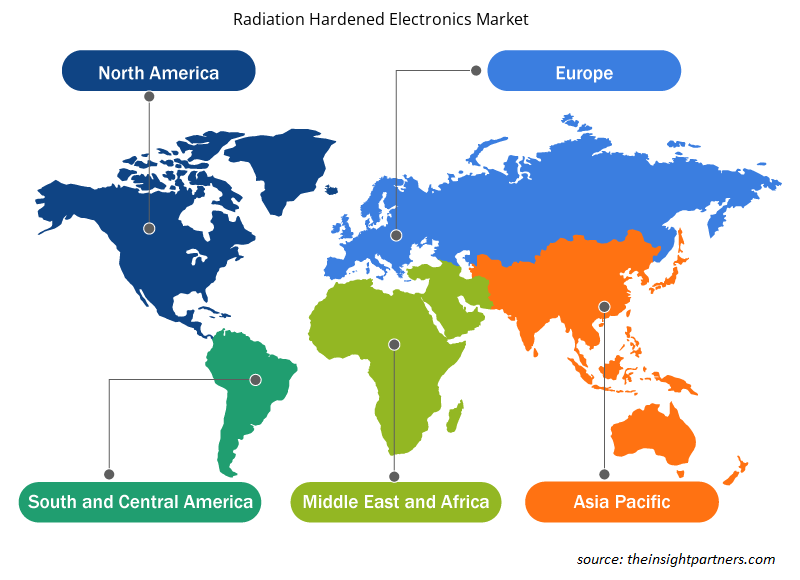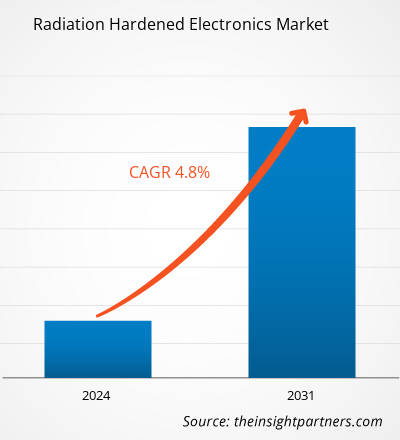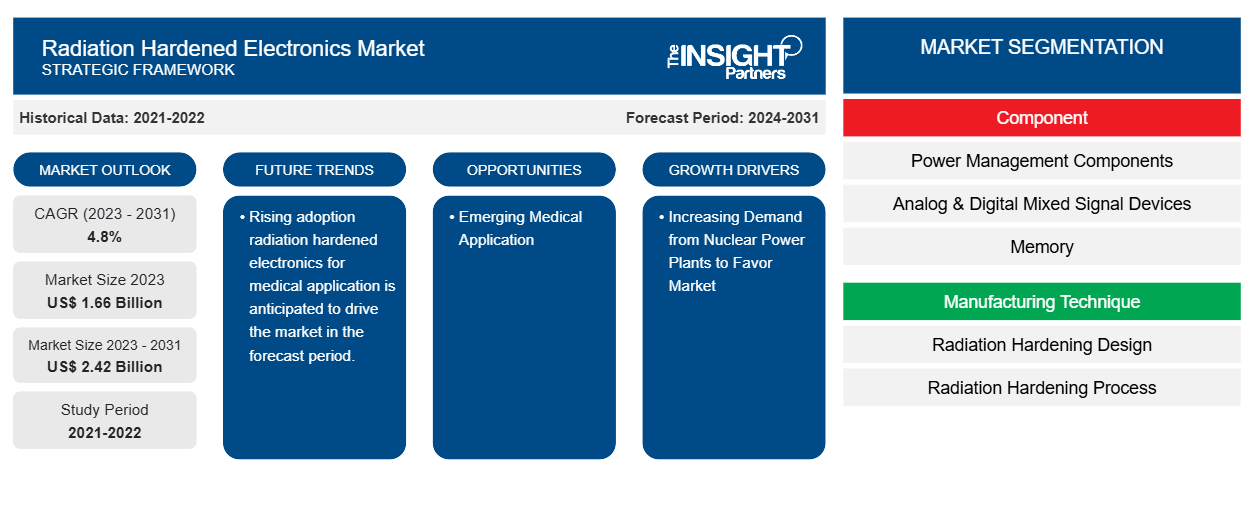Der Markt für strahlungsgehärtete Elektronik wird voraussichtlich von 1,66 Milliarden US-Dollar im Jahr 2023 auf 2,42 Milliarden US-Dollar im Jahr 2031 anwachsen. Der Markt wird zwischen 2023 und 2031 voraussichtlich eine durchschnittliche jährliche Wachstumsrate von 4,8 % verzeichnen. Die zunehmende Verbreitung strahlungsgehärteter Elektronik und die steigenden Investitionen in Raumfahrtprogramme werden voraussichtlich weiterhin wichtige Trends und Treiber des Marktes bleiben.
Marktanalyse für strahlungsgehärtete Elektronik
Die wachsende Nachfrage nach strahlungsgehärteten Rückmeldesensoren bei Herstellern kritischer Geräte und Systeme auf der ganzen Welt dürfte den Markt für strahlungsgehärtete Rückmeldesensoren im Prognosezeitraum ankurbeln. Strahlungsgehärtete Rückmeldesensoren werden häufig in Luft- und Raumfahrt- und Verteidigungssystemen, Raumfahrzeugen, Satelliten, Raumsonden, medizinischen Geräten und anderen eingesetzt. Technologische Fortschritte, die Miniaturisierung strahlungsgehärteter Rückmeldesensoren, die steigende Nachfrage nach erneuerbarer Energie und zunehmende F&E-Aktivitäten treiben den Markt für strahlungsgehärtete Rückmeldesensoren voran.
Marktübersicht für strahlungsgehärtete Elektronik
Strahlungsresistente Rückkopplungssensoren sind Geräte, die hohen Strahlungsniveaus standhalten, wie sie am häufigsten in nuklearen und Weltraumumgebungen auftreten. Diese Sensoren verwenden einen Rückkopplungsmechanismus zur kontinuierlichen Überwachung ihrer Leistung und passen sich entsprechend an, indem sie einen zuverlässigen und genauen Betrieb bei starker Strahlung gewährleisten. Die Sensoren verwenden Rückkopplungsschleifen, um Abweichungen von ihrem erwarteten Verhalten zu erkennen, die durch strahlungsbedingte Schäden verursacht werden.
Passen Sie diesen Bericht Ihren Anforderungen an
Sie erhalten kostenlos individuelle Anpassungen an jedem Bericht, einschließlich Teilen dieses Berichts oder einer Analyse auf Länderebene, eines Excel-Datenpakets sowie tolle Angebote und Rabatte für Start-ups und Universitäten.
-
Holen Sie sich die wichtigsten Markttrends aus diesem Bericht.Dieses KOSTENLOSE Beispiel umfasst eine Datenanalyse von Markttrends bis hin zu Schätzungen und Prognosen.
Treiber und Chancen für den Markt für strahlungsgehärtete Elektronik
Steigende Nachfrage aus Kernkraftwerken begünstigt Markt
Kernkraftwerke erzeugen Elektrizität durch den Prozess der Kernspaltung. Dabei wird eine erhebliche Menge an Energie erzeugt, die eine erhebliche Menge an Strahlung erzeugt. Diese Strahlung ist für den Menschen schädlich und kann elektronische Geräte beschädigen, was den Bedarf an strahlungsgehärteten Rückkopplungssensoren erhöht. Strahlungsgehärtete Rückkopplungssensoren werden strategisch im gesamten Kraftwerk platziert, um Temperaturschwankungen in kritischen Bereichen wie den Kühlmittelsystemen, dem Reaktorkern und verschiedenen Komponenten zu überwachen. Diese Sensoren liefern kontinuierliches Feedback an die Steuerungssysteme, sodass die Anlagenbetreiber die notwendigen Maßnahmen zur Aufrechterhaltung des gewünschten Temperaturbereichs ergreifen und fundierte Entscheidungen zur Verbesserung der Systemleistung treffen können. Mehrere Unternehmen investieren erheblich in die Entwicklung von Kraftwerken. Laut den im Januar 2024 veröffentlichten Daten des US-Energieministeriums (DOE) investierte das DOE beispielsweise rund 12 Milliarden US-Dollar in das Kraftwerk Vogtle, um nach der Inbetriebnahme mehr als 1.100 Megawatt sauberen Strom in das Netz einzuspeisen.Vogtle to provide more than 1,100 megawatts of clean power to the grid once in operation.
Neue medizinische Anwendung.
Strahlungsgehärtete Feedback-Sensoren spielen eine entscheidende Rolle bei der Gewährleistung der Sicherheit, Genauigkeit und Zuverlässigkeit von medizinischen Geräten, die in der Gesundheitsbranche verwendet werden. Diese Sensoren werden in eine Vielzahl von medizinischen Geräten integriert, darunter Gammastrahlen, Röntgenstrahlen und Elektronenstrahlen, indem sie dafür sorgen, dass sie hohen Strahlungsniveaus standhalten. Strahlungsgehärtete Feedback-Sensoren werden hauptsächlich in Strahlentherapiegeräte integriert, um Ärzte bei der Behandlung von Krebspatienten zu unterstützen. Die Strahlentherapie , auch Radiotherapie genannt, ist die häufigste Behandlungsmethode für Krebspatienten, bei der hochenergetische Strahlen eingesetzt werden, um Krebszellen anzuvisieren und zu zerstören. Dazu sind strahlungsgehärtete Feedback-Sensoren erforderlich, um verschiedene Parameter zu überwachen, darunter Dosisabgabe, Strahlendichte und Strahlenpositionierung. Angehörige der Gesundheitsberufe verwenden strahlungsgehärtete Feedback-Sensoren, um eine genaue und präzise Behandlung sicherzustellen und Schäden an gesundem Gewebe zu minimieren. So führte die Maxon Group im April 2022 ENX GAMA-Encoder ein, die für den Einsatz in der Nähe von medizinischen Linearbeschleunigern an Geräten wie Mehrblattkollimatoren entwickelt wurden. ENX GAMA-Encoder sind strahlungsresistente Encoder mit integrierten Gleichstrommotoren, die sich hervorragend für Strahlentherapiegeräte eignen.Maxon Group introduced ENX GAMA encoders designed for use in the vicinity of medical linear accelerators on equipment such as multi-leaf collimators. ENX GAMA encoders are radiation-resistant encoders integrated with DC motors that are highly suitable for radiotherapy devices.
Segmentierungsanalyse des Marktberichts für strahlungsgehärtete Elektronik
Wichtige Segmente, die zur Ableitung der Marktanalyse für strahlungsgehärtete Elektronik beigetragen haben, sind Komponenten, Herstellungsverfahren und Anwendungen.
- Basierend auf den Komponenten ist der Markt für strahlungsfeste Elektronik in Energiemanagementkomponenten, analoge und digitale Mixed-Signal-Geräte, Speicher sowie Controller und Prozessoren unterteilt. Das Segment der Energiemanagementkomponenten dürfte im Prognosezeitraum einen erheblichen Marktanteil halten.
- Basierend auf der Herstellungstechnik ist der Markt für strahlungsgehärtete Elektronik in Strahlungshärtung durch Design (RHBD) und Strahlungshärtung durch Prozess (RHBP) unterteilt. Das Segment Strahlungshärtung durch Design (RHBD) wird im Prognosezeitraum voraussichtlich einen erheblichen Marktanteil halten.
- Nach Anwendungen ist der Markt in Luft- und Raumfahrt und Verteidigung, Kernkraftwerke, Weltraum und andere unterteilt. Es wird erwartet, dass die Luft- und Raumfahrt und Verteidigung im Prognosezeitraum einen erheblichen Marktanteil halten werden.
Strahlungsgehärtete Elektronik Marktanteilsanalyse nach Geografie
Der geografische Umfang des Marktberichts für strahlungsgehärtete Elektronik ist hauptsächlich in fünf Regionen unterteilt: Nordamerika, Asien-Pazifik, Europa, Naher Osten und Afrika sowie Süd- und Mittelamerika.
Nordamerika hat den Markt für strahlungsgehärtete Elektronik dominiert. Die expandierende Raumfahrtindustrie beflügelt den Markt für strahlungsgehärtete Rückkopplungssensoren in Nordamerika. Die USA sind seit mehr als 60 Jahren führend in der Raumfahrt. Sie verfügen über das weltweit größte staatliche Raumfahrtprogramm. Die in den USA registrierten Satelliten machten im Jahr 2022 mehr als die Hälfte aller in Betrieb befindlichen Satelliten aus. Die USA sind derzeit das einzige Land mit einem thematischen Konto für Weltraumaktivitäten. Darüber hinaus zwingt eine starke Betonung von Forschung und Entwicklung in den entwickelten Volkswirtschaften der USA und Kanadas die nordamerikanischen Akteure dazu, technologisch fortschrittliche Lösungen auf den Markt zu bringen. Darüber hinaus gibt es in den USA eine große Anzahl von Akteuren auf dem Markt für strahlungsgehärtete Elektronik, die sich zunehmend auf die Entwicklung innovativer Lösungen konzentrieren. All diese Faktoren tragen zum Wachstum des Marktes für strahlungsgehärtete Elektronik in der Region bei.
Regionale Einblicke in den Markt für strahlungsgehärtete Elektronik
Die regionalen Trends und Faktoren, die den Markt für strahlungsgehärtete Elektronik im Prognosezeitraum beeinflussen, wurden von den Analysten von Insight Partners ausführlich erläutert. In diesem Abschnitt werden auch die Marktsegmente und die Geografie für strahlungsgehärtete Elektronik in Nordamerika, Europa, im asiatisch-pazifischen Raum, im Nahen Osten und Afrika sowie in Süd- und Mittelamerika erörtert.

- Erhalten Sie regionale Daten zum Markt für strahlungsgehärtete Elektronik
Umfang des Marktberichts über strahlungsgehärtete Elektronik
| Berichtsattribut | Details |
|---|---|
| Marktgröße im Jahr 2023 | 1,66 Milliarden US-Dollar |
| Marktgröße bis 2031 | 2,42 Milliarden US-Dollar |
| Globale CAGR (2023 - 2031) | 4,8 % |
| Historische Daten | 2021-2022 |
| Prognosezeitraum | 2024–2031 |
| Abgedeckte Segmente |
Nach Komponente
|
| Abgedeckte Regionen und Länder |
Nordamerika
|
| Marktführer und wichtige Unternehmensprofile |
|
Marktteilnehmerdichte: Der Einfluss auf die Geschäftsdynamik
Der Markt für strahlungsfeste Elektronik wächst rasant, angetrieben durch die steigende Nachfrage der Endnutzer aufgrund von Faktoren wie sich entwickelnden Verbraucherpräferenzen, technologischen Fortschritten und einem größeren Bewusstsein für die Vorteile des Produkts. Mit steigender Nachfrage erweitern Unternehmen ihr Angebot, entwickeln Innovationen, um die Bedürfnisse der Verbraucher zu erfüllen, und nutzen neue Trends, was das Marktwachstum weiter ankurbelt.
Die Marktteilnehmerdichte bezieht sich auf die Verteilung von Firmen oder Unternehmen, die in einem bestimmten Markt oder einer bestimmten Branche tätig sind. Sie gibt an, wie viele Wettbewerber (Marktteilnehmer) in einem bestimmten Marktraum im Verhältnis zu seiner Größe oder seinem gesamten Marktwert präsent sind.
Die wichtigsten Unternehmen auf dem Markt für strahlungsgehärtete Elektronik sind:
- BAE Systems
- Data Device Corporation
- Honeywell International Inc.
- Infineon Technologies AG
- Renesas Electronics Corporation
- Texas Instruments Incorporated
Haftungsausschluss : Die oben aufgeführten Unternehmen sind nicht in einer bestimmten Reihenfolge aufgeführt.

- Überblick über die wichtigsten Akteure auf dem Markt für strahlungsgehärtete Elektronik
Nachrichten und aktuelle Entwicklungen zum Markt für strahlungsfeste Elektronik
Der Markt für strahlungsgehärtete Elektronik wird durch die Erhebung qualitativer und quantitativer Daten nach Primär- und Sekundärforschung bewertet, die wichtige Unternehmensveröffentlichungen, Verbandsdaten und Datenbanken umfasst. Nachfolgend sind einige der Entwicklungen auf dem Markt für strahlungsgehärtete Elektronik aufgeführt:
- EPC Space hat den EPC7009L16SH vorgestellt, einen strahlungsgehärteten Galliumnitrid (GaN)-Gate-Treiber-IC. Dieser innovative GaN-Treiber nutzt die exklusive eGaN-IC-Technologie von EPC und ermöglicht es Konstrukteuren, die Möglichkeiten der eGaN-FET-Technologie voll auszuschöpfen. (Quelle: EPC Space, Unternehmenswebsite, April 2024)
- Renesas Electronics Corporation, ein Anbieter fortschrittlicher Halbleiterlösungen, hat eine neue Produktlinie strahlungsfester (rad-hard) Bauelemente in Kunststoffgehäusen für Energiemanagementsysteme von Satelliten auf den Markt gebracht. Zu den vier neuen Bauelementen gehören der Point-of-Load-(POL)-Abwärtsregler ISL71001SLHM/SEHM, die digitalen Isolatoren ISL71610SLHM und ISL71710SLHM sowie der 100-V-GaN-FET ISL73033SLHM und der integrierte Low-Side-Treiber. (Quelle: Renesas Electronics Corporation, Unternehmenswebsite, Juli 2021)
Marktbericht zu strahlungsgehärteter Elektronik – Umfang und Ergebnisse
Der Bericht „Marktgröße und Prognose für strahlungsgehärtete Elektronik (2021–2031)“ bietet eine detaillierte Analyse des Marktes, die die folgenden Bereiche abdeckt:
- Marktgröße und Prognose für strahlungsgehärtete Elektronik auf globaler, regionaler und Länderebene für alle abgedeckten wichtigen Marktsegmente.
- Markttrends für strahlungsgehärtete Elektronik sowie Marktdynamik wie Treiber, Einschränkungen und wichtige Chancen.
- Detaillierte PEST/Porters Five Forces- und SWOT-Analyse.
- Analyse des Marktes für strahlungsgehärtete Elektronik, die wichtige Markttrends, globale und regionale Rahmenbedingungen, wichtige Akteure, Vorschriften und aktuelle Marktentwicklungen abdeckt.
- Branchenlandschaft und Wettbewerbsanalyse, einschließlich Marktkonzentration, Heatmap-Analyse, prominenten Akteuren und aktuellen Entwicklungen für den Markt für strahlungsgehärtete Elektronik.
- Detaillierte Firmenprofile.
- Historische Analyse (2 Jahre), Basisjahr, Prognose (7 Jahre) mit CAGR
- PEST- und SWOT-Analyse
- Marktgröße Wert/Volumen – Global, Regional, Land
- Branchen- und Wettbewerbslandschaft
- Excel-Datensatz
Aktuelle Berichte
Erfahrungsberichte
Grund zum Kauf
- Fundierte Entscheidungsfindung
- Marktdynamik verstehen
- Wettbewerbsanalyse
- Kundeneinblicke
- Marktprognosen
- Risikominimierung
- Strategische Planung
- Investitionsbegründung
- Identifizierung neuer Märkte
- Verbesserung von Marketingstrategien
- Steigerung der Betriebseffizienz
- Anpassung an regulatorische Trends























 Kostenlose Probe anfordern für - Markt für strahlungsgehärtete Elektronik
Kostenlose Probe anfordern für - Markt für strahlungsgehärtete Elektronik